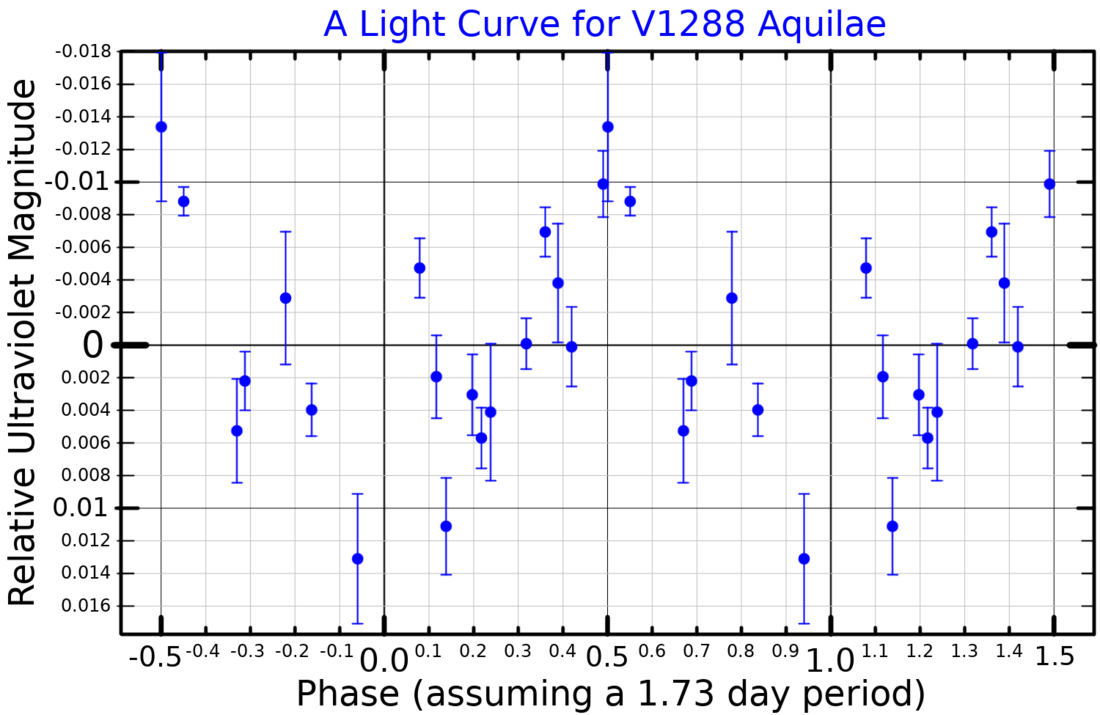21 Aquilae
Star in the constellation Aquila From Wikipedia, the free encyclopedia
21 Aquilae is a solitary[14] variable star in the equatorial constellation of Aquila. It has the variable star designation V1288 Aql; 21 Aquilae is its Flamsteed designation. This object is visible to the naked eye as a dim, blue-white hued star with a baseline apparent visual magnitude of about 5.1. The star is located at a distance of around 680 light-years (210 parsecs) from Earth, give or take a 20 light-year margin of error. It is moving closer to the Earth with a heliocentric radial velocity of –5 km/s.[6]
| Observation data Epoch J2000 Equinox J2000 | |
|---|---|
| Constellation | Aquila |
| Right ascension | 19h 13m 42.70120s[2] |
| Declination | +02° 17′ 37.3103″[2] |
| Apparent magnitude (V) | 5.06 - 5.16[3] |
| Characteristics | |
| Spectral type | B8II-III(Hg?)[4] |
| U−B color index | −0.399[5] |
| B−V color index | −0.065[5] |
| Variable type | α2 CVn[3] |
| Astrometry | |
| Radial velocity (Rv) | −5.2[6] km/s |
| Proper motion (μ) | RA: +10.102[2] mas/yr Dec.: −0.825[2] mas/yr |
| Parallax (π) | 4.7730±0.1052 mas[2] |
| Distance | 680 ± 20 ly (210 ± 5 pc) |
| Absolute magnitude (MV) | −2.12[7] |
| Details | |
| Mass | 6.7[8] M☉ |
| Radius | 6.2[9] R☉ |
| Luminosity | 704[8] L☉ |
| Surface gravity (log g) | 3.95[8] cgs |
| Temperature | 12,014[8] K |
| Metallicity [Fe/H] | −0.20[10] dex |
| Rotation | 9.3 d[11] |
| Rotational velocity (v sin i) | 17[10] km/s |
| Age | 165[12] Myr |
| Other designations | |
| 21 Aql, V1288 Aql, BD+02°3824, FK5 3537, HD 179761, HIP 94477, HR 7287, SAO 124408, WDS J19137+0218A[13] | |
| Database references | |
| SIMBAD | data |
In 1962, Helmut A. Abt and John C. Gloson published data showing that 21 Aquilae was a variable star.[15] Based on that publication, the star was given its variable star designation in 1972.[16]
The stellar classification of this star is B8 II-III, with the luminosity class of II-III suggesting that the spectrum displays elements of both a giant star and a bright giant. It is a chemically peculiar star of the Mercury-Manganese type (CP3),[10] although some catalogues consider that status to be doubtful.[17] This is a probable Alpha2 Canum Venaticorum variable that ranges in visual magnitude from 5.06 down to 5.16.[3] The star is radiating 704 times the luminosity of the Sun from its photosphere at an effective temperature of 12,014 K; this gives it the blue-white glow of a B-type star.[18]
21 Aquilae is catalogued as an optical double star, having a 12th magnitude companion 37″ away as of 2010. It was first identified as a double star by John Herschel.[19] The companion is a distant background object.[20]
References
External links
Wikiwand - on
Seamless Wikipedia browsing. On steroids.

